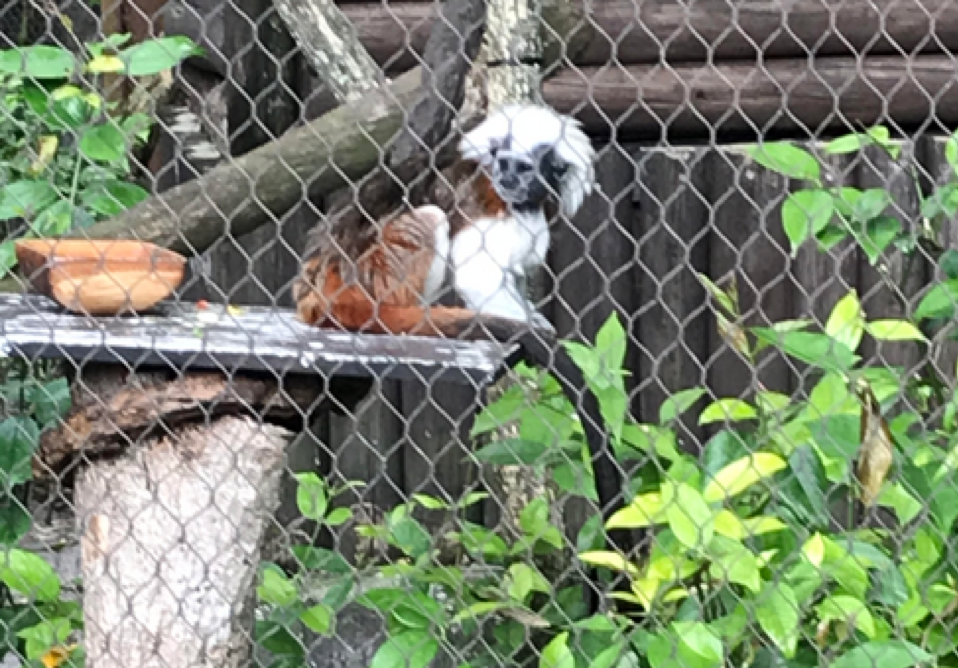Animal Kingdom hosts hundreds of species of animals, from elephants to rare birds. Creatures well-known and obscure fill nooks and crannies throughout the Park. While it is thrilling to see the lions on Kilimanjaro Safaris and tigers on Maharajah Jungle Trek, all creatures at the Park are worth observing. There are four, in particular, I would recommend visiting, which Guests may generally overlook.
Cotton-Top Tamarin
The Cotton-Top Tamarin is a small monkey that is only found in Northwestern Colombia. Named for the white hair on the top of their head, the species is one of the most endangered primates on the planet. The pleasingly playful monkeys are found on Animal Kingdom’s Discovery Island in an enclosure on the left side of the Tree of Life, as one heads to Africa.
Their habitat at Animal Kingdom is located across from Creature Comforts, which includes the Starbucks Flat White Latte on its menu. The Walt Disney World website describes the drink as a, “…slightly sweet espresso treat—blended with bold ristretto shots and steamed whole milk for a smooth, velvety flavor.” Sales of the Latte help support continued conservation efforts. The Disney Conservation Fund provides support to Proyecto Tití, a Colombian organization dedicated to Tamarin’s welfare.
The creamy white dollop atop the beverage is similar to the tuft of hair on the Tamarin’s head, leading to its selection. If you find yourself needing a break as you traverse through the Park, grab a Flat White Latte and watch these animals for a few minutes as they jump around and enjoy their lush habitat.

The Cotton-Tops hail from South America, a continent which otherwise has an infrequent presence in the Parks. Located on a high-traffic thoroughfare, their play and antics remind me of kittens, and the monkeys are a joy to watch. They are located in a great spot where a group can recongregate. The area is near Creature Comforts, where beverages, restrooms, seating, and shade are available.
Wallaby
The Wallaby is located in the heart of the Oasis, which is the area one walks through as you enter the Park. Two forks lead guests to Discovery Island. But this area also includes two pathways through pools and lush flora and fauna. The Marsupial lives off of a pathway in the middle of the Oasis adjacent to a variety of birds.
The animals weigh about 15-20 pounds and live in a verdant habitat, giving them plenty of shade. They generally stay amongst shrubs during the day and emerge at night. The species here is native to Southwest Australia. At least two joey’s (babies) have been born at Animal Kingdom. When born, the Wallaby is the size of an acorn and lives in its mother’s pouch for several months.

Blending in extraordinarily well, and often hiding toward the back of their habitat, the Wallaby can be difficult to spot. But it makes sightings of them rewarding. The specific pathway the Wallaby lives on is great to meander through and cool off before leaving the Park. On scorching hot and busy days, the bus stop feels especially brutal; therefore, getting a brief respite from crowds and heat can help make the journey back to the Resort less arduous. Perhaps with the help of a cool beverage from Creature Comforts, the commute could even become quite pleasant!
Naked Mole Rats
Naked Mole Rats reside in Kenya, Somalia, and Ethiopia and, fortunately, are not endangered or threatened! The Naked Mole Rats are located on Gorilla Falls Exploration Trail in Africa, after the Okapi exhibit. These rodents live in a series of tunnels and chambers which can be seen through the glass. They are in a building that includes turtles, snakes, and insects.
The Naked Mole Rat generally weighs 1.2 to 2.8 ounces and subsists on a diet of roots and tubers in the wild. While in captivity, they are generally fed leafy vegetables and various fruits. As seen on the Trail, they live in elaborate underground burrow systems dug into hard soil. Each rodent has a specific purpose, such as digging tunnels or caring for the young. Individual chambers also serve a certain purpose. Colonies have between 20 to 300 members in an area that can span six football fields.

I did not go to Animal Kingdom as a very young child but remember being repeatedly transfixed by a similar exhibit at the Philadelphia Zoo. And I imagine small children today would continue to be hypnotized by the idea of the unique animals living in an underground city. The Gorilla Falls Exploration Trail includes, from my experience, the most friendly and engaging Cast Members on Walt Disney World property. They especially appreciate it when I wear my Pangani Forest Exploration Trail t-shirt (the Trails name from 1998-2016). Cast Members who work there routinely know the names of animals, how they relate to each other and have interesting stories they freely share.
After
the re-opening of the Parks, the area in the building where one can see these
animals up close was roped off. Guests
had to essentially just walk through the building in an effort to encourage social
distancing. The ability to see the Naked
Mole Rats up close is one of the last dominoes to fall in the world of pandemic-related
restrictions.
Lemurs
Two species of lemur live in a habitat at the base of the Tree of Life: Collared-Brown and Ring-Tailed. Their spot is located to the right of the Tree as one walks to Asia. The lemurs are especially adept at blending into their environment, and when they are not playing, seeing them requires patience. This animal is native to Madagascar, off of the Southeastern coast of Africa. Over 100 species of lemur live in Madagascar, and both species at Animal Kingdom are listed as endangered. Some species are critically endangered and at risk of extinction.

Ring-Tailed
Lemurs once resided at Discovery Island in Bay Lake, which eventually closed in
1999. Some animals from Discovery Island
were relocated to zoos around the country, and others to Animal Kingdom,
including Ring-Tailed Lemurs. Perhaps at
one point in time, guests were observing animals who once resided elsewhere on
property!
The lemur habitat is relatively easy to miss if one is in a hurry. I like to stop by there before or after lunch at Flame Tree Barbecue and see if anyone is up and moving. The location also provides great photo opportunities at the Tree from a different angle. Moseying along to the front, and eventually seeing flamingos, kangaroos, and vultures is a great way to migrate to Africa or Pandora- the World of AVATAR. Heading the other way leads easily to Asia and DinoLand U.S.A. It can feel like a serene spot in the middle of a Walt Disney World theme park.
Do you have any must-do creatures you visit when in Animal Kingdom? Are there any animals or areas of Animal Kingdom you would care to learn more about? Please feel free to leave a comment!
Source: Disney Parks Blog

